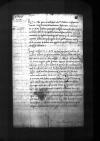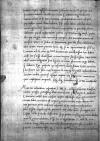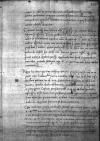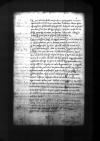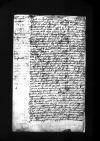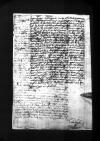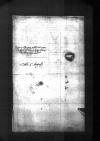Institueram manu mea Dominationi Vestrae Reverendissimae scribere, verum cum vidissem me non satis bene pingere, ne lituris meis Dominationi Vestrae Reverendissimae in lectione essem molestior, praescripsi amanuensi, qui legibilius quam ego, cum mea quae scribo interdum legere nequeam, scribit. Det quaeso igitur Dominatio Vestra Reverendissima veniam nihilque ob id ex veteri et debita mea erga Dominationem Vestram Reverendissimam observantia decessisse arbitretur. ⌊⌋ novissime Dominationi Vestrae Reverendissimae 1534-06-03⌊III-a Iunii1534-06-03⌋ copiosius, quam tum me ob oculorum dolorem scripturum putabam. Interea redditae mihi sunt, cum nuntius meus ex ⌊Vilna⌋ rediisset, ⌊serenissimae maiestatis regiae⌋ ⌊⌋ vivam erga me et vere ⌊regiam⌋ gratiam spirantes, quarum his adiunxi exemplum, habuerunt tamen in fine aculeum et quandam de me dubitationem, quasi ab instituto animi mei dudum observato declinare aliquando possem. Quod Deo bene favente numquam futurum est, quam diu hanc molem incolo carneam. Sacra vero ⌊reginalis maiestas⌋ quam adhuc inclementer et minaciter mihi scribat, ex copia ⌊⌋ Dominatio Vestra Reverendissima etiam cognoscet. cf. Gel. XVII 14.4-6 Malum est consilium, quod mutari non potest. Feras, non culpes, quod vitari non potest. ⌊Quod itaque nescio quibus malis fatis mutare non possum, ferre cogorcf. Gel. XVII 14.4-6 Malum est consilium, quod mutari non potest. Feras, non culpes, quod vitari non potest. ⌋. Omnem istam afflictionem meam, quemadmodum ex litteris ⌊reginalis maiestatis⌋ liquet, a ⌊reverendissimo domino Gnesnensi⌋ (cui Deus hanc erga me malevolentiam ignoscat) patior, qui non secus atque iam convictus essem, in his, quibus me arguit et obiurgat, de me scribit et pronuntiat, cum tamen candor et innocentia mea longe aliud demonstret. Scripsi in ⌊⌋, quod debitum centum ducatorum, quo ⌊dominationi eius reverendissimae⌋ obligabar, defalcatis XXX ducatis, quos nepos eius mihi debuit, ⌊Gedani⌋ reponi iussissem in manus scribae dominationis eius reverendissimae, qui tum cum frumentis aderat, ille autem non minus quam centum integros ducatos habere voluit et sic eam pecuniam apud quendam civem reliquit, quae adhuc apud illum habetur. Est mihi adhuc ⌊⌋ alius, manu ipsius domini ⌊Ioannis Drevicii⌋ conscriptus, in quo mihi plura debentur, quae ob austeritatem patrui repetere hucusque omisi praeter illa, quae integro anno, uno mense excepto, cum uno equo vivens(!) ad mensam meam in ⌊Italia⌋ et ⌊Germania⌋, pro illo solvi, nihilominus adeo exacta mecum ponitur ratio. Quod si in ⌊Squirniowicze⌋, cum ex ⌊Cracovia⌋ ad ⌊dominationem eius reverendissimam⌋ deverteram, intellexissem hoc debitum mihi non fuisse dimissum, eo tum tempore satisfecissem. Non tamen ob id tanta indignatione sum dignus, ut etiam plus a me exigi debeat, quam debeam. Ego profecto, qui inferioris etiam status hominum amicitias flocci facere non soleo, maximopere ⌊dominationis eius reverendissimae⌋ gratiam, nedum benevolentiam ambio, quam si assequi nequeo, non sunt primi conatus mei, quos nequicquam impendi,
cf. Gel. XVI 9 ⌊susque deque ferendum estcf. Gel. XVI 9 ⌋ et Deo committendum.
Mitto his adiunctum responsum ⌊serenissimae maiestatis regiae⌋ ad litteras ⌊dominorum consiliariorum Prussiae⌋ potuissetque illud unico decreto pro futuro Sancti Michaelis[1] ⌊conventu⌋ omnem hanc odiosam causam absolvisse. Cum igitur tractari iterum debet, verendum est, ne quid gravius incidat, unde obductae iam non parva ex parte cicatrices refricari et in crudum rursus vulnus solvi possint. Quod ne fiat, pro virili mea dabo operam. In negotio cum ⌊Costka⌋ nulla fuit alia difficultas, quam quod petere, ut sibi ignosceretur, debebat, quod illi grave videbatur et igitur hoc in cognitionem ⌊serenissimae maiestatis regiae⌋ fuit reiectum hocque maiestas eius uno verbo determinare potuisset et adhuc in futuro ⌊conventu⌋ posset. Quod si Dominatio Vestra Reverendissima eam sententiam et declarationem ⌊serenissimae maiestatis regiae⌋ ea in re obtineret, ne (quod vereor) gravius in animis exulceratis quippiam oriatur, faceret rem communi nostrae tranquillitati apprime commodam et necessariam et qua sibi omnium hic animos plurimum devinciret.
Continui hucusque hunc nuntium meum, si quid scriptu interea de novis dignum se offerret. Et ecce, quod nos omnes vehementer in animis consternavit et perturbavit maxime, novum de adversa ⌊serenissimae maiestatis regiae⌋ valetudine affertur, etiam cum rumore quodam (quam Deus quam diutissime prohibeat) mortis. Verum paulo post litterae ⌊serenissimae maiestatis eius⌋ nos erexerunt, quibus de salute sua maiestas eius bene nos sperare iussit. Quod si illa fieret mutatio dexterae excelsi, quid inde boni foret exspectandum, non video, proinde summopere rogo Dominatio Vestra Reverendissima me velit in his reddere certiorem etc.
Nova his iunxi, quae ⌊dux Holsaciae⌋ ⌊duci in Prussia⌋ scripsit. Omnia ea in parte cum ⌊Lubecensibus⌋ sunt in tumultu. Dominus ⌊dux⌋ ex ⌊Gdano⌋ misit vexillum peditum, hoc est 500, ⌊sororio⌋ suo in subsidium acceptis a domino ⌊Ioanne a Werden⌋ decem milibus marcis Prutenis in mutuum, pro quibus ei pro pignore ⌊castrum Preuschemarckt⌋ et ea, quae ad illud spectant, inscripsit. Misit etiam mari quasdam ex ⌊Monte Regio⌋ naves, ut suppetias ferat ⌊affini⌋ suo, quarum unam et aliam civium mercatoriam interceperunt ⌊Lubecenses⌋. Quid inde futurum est, brevi experiemur. Cum dominus ⌊dux Prussiae⌋ intellexisset statuisse me nuntium mittere ad Dominationem Vestram Reverendissimam, has adiunctas Dominationi Vestrae Reverendissimae inscriptas ad me misit, petens a me, ut causam eius cum ⌊magno ducatu Lituaniae⌋ ob oras et terminos Dominationi Vestrae Reverendissimae commendarem. Quod cum etiam publicam tranquillitatem concernit, impense rogo Dominationem Vestram Reverendissimam desiderio et votis ⌊ipsius domini ducis⌋, quantum potest et licet, satisfaciat. Dominus ⌊dux⌋, ut scripsi in novissimis, non convenit cum ⌊Ioachimo marchione iuniore⌋, qui, ut intellexi, pacta coniugii cum ⌊duce Brunsvicensi⌋ tractat etc. Quod pro ⌊domino duce⌋ scribo, non fit abs re, quandoquidem ut vicinus optime mecum convenit et non adeo illum ecclesiarum nostrarum osorem esse existimo, quemadmodum sunt plurimi, dedit enim mihi ex propinquioribus silvis suis omnia ligna, quae pro reparatione exustae hic meae ecclesiae, quam usque ad tectum rursus erexi, habere volui multoque in multis quam prius factus est sacris nostris propensior etc. Quae in novissimis scripsi de negotio Varmiensi, si ad eum modum Dominationi Vestrae Reverendissimae videbitur, per dominum ⌊Ioannem a Werden⌋ tuto multa Dominatio Vestra Reverendissima transigere potest. ⌊Reverendissimus dominus Varmiensis⌋ valde sibi metuit, ut si (quod Deus avertat) ⌊serenissima maiestas regia⌋ decederet, magnam apud nos ecclesiasticorum perturbationem et persecutionem futuram. Quod idem ob decimas fortassis aliquas non datas et ⌊reverendissimus dominus Gnesnensis⌋, cuius ea de re ad dominum Varmiensem vidi litteras, aperte in ⌊Regno⌋ formidat, consulendum nobis esset temporius in medium. Ego quidem adhuc non omni spe destituor, neque adeo me turbae illae Germanicae per ⌊lantgrabium Hessiae⌋ excitatae permovent, ut putem caelum ruiturum, neque aliquem episcoporum prorsus expulsum scio praeter Lubecensem, qui apud gentem agebat acephalam. Quod si, ut certo mihi scriptum est, pro Septembri venturo ⌊caesar⌋ ex ⌊Hispaniis⌋ redierit, non deerunt ei consilia vires opes et amici, quibus pontificem ⌊Gallum⌋ et eius complices atque ⌊Hessum⌋ a nefariis conatibus reprimat. Deus tandem, ut confido, ecclesiae suae et nostri, modo resipiscamus et ad cf. Vulg. Ps (G) 63.7 ⌊cor altumcf. Vulg. Ps (G) 63.7 ⌋ redeamus, miserebitur. In hac persto sententia. Si quam pro sua prudentia incomparabili Dominatio Vestra Reverendissima perspicaciorem et certiorem in eo habet, quaeso me illius participem faciat. Quod reliquum est, me in gratiam Dominationis Vestrae Reverendissimae ex corde commendo atque dedo Deumque precor eandem pro mea et omnium bonorum consolatione quam diutissime in optima valetudine valere et felicissime vivere concedat.
Reverendissime in Christo Pater et Domine, domine mi colendissime.
Obsequiorum meorum et mei plurimam commendationem etc.
Cum iam istas obserassem, rediit ab illustri domino ⌊duce Prussiae⌋ affinis meus utriusque iuris doctor ⌊Ioannes Reinecius⌋ et inter multa alia mihi rettulit, quae ad me dominus dux nuntiavit, quod conventus ille cum marchione iuniore Brandenburgensi Ioachimo, de quo in novissimis Dominationi Vestrae Reverendissimae scripsi, ob eas turbas, quae passim in Germania habebantur, non successisset, cum autem nunc aliqua ex parte pacatae essent, conventurum dominum ducem Prussiae cum iuniore Ioachimo Brandenburgensi post paucos hos dies
Posnaniae inibique tractatus futuros, quibus Deo bene favente coniugium hoc, Dominationi Vestrae Reverendissimae non incognitum, concludi possit. Et quod ob eas turbas dominus dux
pedites et equites aliquot suscipiat nostrates ad castrorum suorum munitionem, ne se lantgrabius Hessiae, qui contra Lubecenses ad ducem Holsaciae proficiscitur, cum dissolverit exercitum, hominum malorum congeries ad turbandum hic res nostras huc praeter spem diverteret. Dux Holsaciae cum vicinis principibus, cum
quibus habet duo milia equitum praeter aliquot milia peditum, acriter civitatem Lubecensem obequitat et omnem arcet commeatum, exussit etiam circumquaque civitatem hortos illorum deliciarum et praedia eritque obsidio longe gravior, si cum suis lantgrabius appulerit et
si forte fortuna in ea obsidione feliciter cedet militibus, ut civitatem cum divite praeda interceperint, verendum est, ne victores animi insolentium militum huc ad nos ulterius provehantur, quod ne fiat, videretur mihi publicis regnicolarum et nostrorum commerciis
apprime expedire, quod serenissima maiestas regia ad eos in obsidione principes scriberet vel potius mitteret aliquem industrium, qui eos bonis modis et rationibus averteret, ne cum illa civitate, sine cuius nostri commercio esse non possunt, extrema experirentur saciusque
esse mihi visum est, ut opera impendatur, qua haec hominum turba dissolvatur, quam ut ad nos (quod Deus avertat) descendat. Scimus, quid desperatorum hominum, ut istiusmodi sunt militum animi, possint, quod nuper Roma, cum nihil tale speraret, maxime est experta etc.
Lubecenses etiam, cum per defectionem ad se intercepissent, ut scripsi, primam Daniae
civitatem Copenhagen, ter magnis viribus cum multorum suorum internicione castrum oppugnarunt et in quarta oppugnatione, in qua proconsul ille Lubecensium, quem plebs i
<n>
stituit et omnia in eam seditionem miscuit, Wolwenwefer nomine, occubuit et cum eo de Lubecensium primis
non pauci castrum ceperunt, ad quod et ad civitatem recuperandam miles quidem de primis regni Daniae, Crabbe nomine, cum exercitu triginta milium proficiscitur regemque sibi praelati et nobilitas regni Daniae ipsum ducem Cristiernum Holsatiae elegerunt habetque Gustavus, qui Sueciae regem se scribit XII naves bene armatas contra Lubecenses in mari, qui Danis et Cristierno Holsato adhaeret, Lubecensibus paucis admodum civitatibus habentibus, qui illorum partes sequuntur, non reor eos, nisi per externos tractatus interponantur, diu subsistere posse. Est etiam comes de Hoge, quem dicunt, fugientem ex Suecia affinem suum Gustavum ad Livonienses, ad serenissimum dominum nostrum in Lituaniam pervenisse et quia cum Lubecensibus aperte sensit, non esset commodum, quod illi plus aequo faveri deberet. Mihi in his et aliis, cum adhuc ea, quae a me prodeunt, in calumniam rapiuntur, in curia nostra non licet, nisi ad Dominationem Vestram Reverendissimam scribere, quae pro sua in me gratia et pro fide et integritate mea, Dominationi Vestrae Reverendissimae non incognita, omnia optimi consulat et me sacellanum suum commendatum habeat.
Ex ⌊castro Lubaviensi⌋, 5 Augusti anno Domini 1534.
Reverendissimae Dominationis Vestrae deditissimus ⌊Culmensis episcopus⌋ scripsit.
